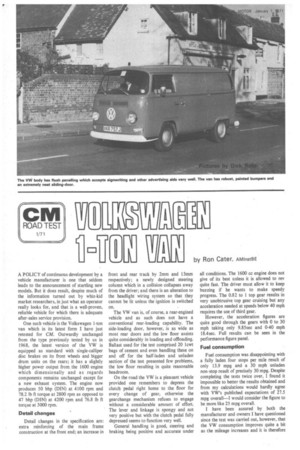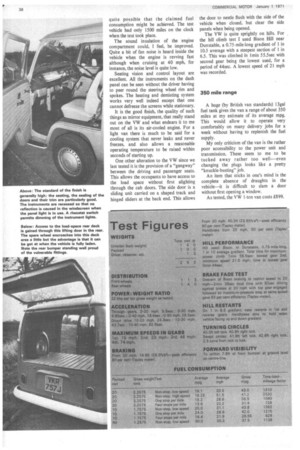CM ROAD TEST
Page 38

Page 40

If you've noticed an error in this article please click here to report it so we can fix it.
1027
11.1\111.1 by Ron Cater, AMInstBE
A POLICY of continuous development by a vehicle manufacturer is one that seldom leads to the announcement of startling new models. But it does result, despite much of the information turned out by whiz-kid market researchers, in just what an operator really looks for, and that is a well-proven, reliable vehicle for which there is adequate after-sales service provision.
One such vehicle is the Volkswagen 1-ton van which in its latest form I have just retested for CM. Outwardly unchanged from the type previously tested by us in 1968, the latest version of the VW is equipped as standard with single-calliper disc brakes on its front wheels and bigger drum units on the rears; it has a slightly higher power output from the 1600 engine which dimensionally and as regards components remains unchanged except for a new exhaust system. The engine now produces 50 bhp (DIN) at 4100 rpm and 78.2 lb ft torque at 2800 rpm as opposed to 47 bhp (DIN) at 4200 rpm and 76.8 lb ft torque at 3000 rpm.
Detail changes
Detail changes in the specification are: extra reinforcing of the main frame construction at the front end; an increase in front and rear track by 2mm and 13mm respectively; a newly designed steering column which in a collision collapses away from the driver; and there is an alteration to the headlight wiring system so that they cannot be lit unless the ignition is switched on.
The VW van is, of course, a rear-engined vehicle and as such does not have a conventional rear-loading capability. The side-loading door, however, is as wide as most rear doors and the low floor assists quite considerably in loading and offloading. Ballast used for the test comprised 20 lcwt bags of cement and even handling these on and off for the half-laden and unladen section of the test presented few problems, the low floor resulting in quite reasonable headroom.
On the road the VW is a pleasant vehicle provided one remembers to depress the clutch pedal right home to the floor for every change of gear, otherwise the gearchange mechanism refuses to engage without a considerable amount of effort. The lever and linkage is spongy and not very positive but with the clutch pedal fully depressed seems to function very well.
General handling is good, steering and braking being positive and accurate under all conditions. The 1600 cc engine does not give of its best unless it is allowed to rev quite fast. The driver must allow it to keep buzzing if he wants to make speedy progress. The 0.82 to 1 top gear results in very unobtrusive top gear cruising but any acceleration needed at speeds below 40 mph requires the use of third gear.
However, the acceleration figures are quite good through the gears with 0 to 30 mph taking only 9.85sec and 0-40 mph 18.4sec. Full results can be seen in the performance figure panel.
Fuel consumption
Fuel consumption was disappointing with a fully laden four stops per mile result of only 13.9 mpg and a 30 mph unladen non-stop result of precisely 30 mpg. Despite completing the tests twice over, I found it impossible to better the results obtained and from my calculations would hardly agree with VW's published expectations of 27.5 mpg overall—I would consider the figure to be more like 25 mpg overall.
I have been• assured• by both the manufacturer and owners I have questioned since the test was carried out, however, that the VW consumption improves quite a bit as the mileage increases and it is therefore quite possible that the claimed fuel consumption might be achieved. The test vehicle had only 1500 miles on the clock when the test took place.
The sound insulation of the engine compartment could, I feel, be improved. Quite a bit of fan noise is heard inside the vehicle when the engine is revving fast although when cruising at 40 mph, for instance, the noise level is quite low.
Seating vision and control layout are excellent. All the instruments on the dash panel can be seen without the driver having to peer round the steering wheel rim and spokes. The heating and demisting system works very well indeed except that one cannot defreeze the screens while stationary.
It is the good finish, the quality of such things as mirror equipment, that really stand out on the VW and what endears it to me most of all is its air-cooled engine. For a light van there is much to be said for a cooling system that never leaks and never freezes, and also allows a reasonable operating temperature to be raised within seconds of starting up.
One other alteration to the VW since we last tested it is the provision of a "gangway" between the driving and passenger seats. This allows the occupants to have access to the load space without first alighting through the cab doors. The side door is a sliding unit carried on a shaped track and hinged sliders at the back end. This allows the door to nestle flush with the side of the vehicle when closed, but clear the side panels when being opened.
The VW is quite sprightly on hills. For the hill climb test I used Bison Hill near Dunstable, a 0.75-mile-long gradient of 1 in 10.5 average with a steepest section of 1 in 6.5. This was climbed in lmin 55.5sec with second gear being the lowest used, for a period of 44sec. A lowest speed of 21 mph was recorded.
350 mile range A huge (by British van standards) 13gal fuel tank gives the van a range of about 350 miles at my estimate of its average mpg. This would allow it to operate very comfortably on many delivery jobs for a week without having to replenish the fuel supply.
My only criticism of the van is the rather poor accessibility to the power unit and transmission. These seem to me to be tucked away rather too well--even changing the plugs looks like a pretty "knuckle-busting" job.
An item that sticks in one's mind is the complete absence of draughts in the vehicle-it is difficult to slam a door without first opening a window.
As tested, the VW 1-ion van costs £899.




















































































